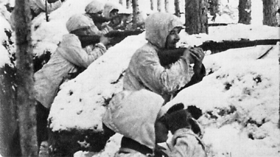Nepali-Bhutania Campaign
This article is incomplete because it is pending further input from participants, or it is a work-in-progress by one author. Please comment on this article's talk page to share your input, comments and questions. Note: To contribute to this article, you may need to seek help from the author(s) of this page. |
| Nepali-Bhutania Campaign | |||||||
|---|---|---|---|---|---|---|---|
| Part of the Liberation of Indiae of the Second Europan War | |||||||
 Balambian troops in the Himalaeyan Mountain Range | |||||||
| |||||||
| Belligerents | |||||||
| Commanders and leaders | |||||||
| Strength | |||||||
|
175,000 troops 750 tanks 600 aircraft 250 guns |
200,000 troops 900 tanks 500 aircraft 275 guns | ||||||
| Casualties and losses | |||||||
| Light to Moderate | Heavy | ||||||
The Nepali-Bhutania Campaign (1 February 1943 - 2 September 1943) were a series of battles that occurred in Nepali and Bhutania. It primarily involved the allied forces led by the United Kingdom, supported by several Lucis Commonwealth countries, Esthar and Balamb, and the Free Bethausian forces against the Empire of Quenmin, supported by Archadia and Rumania.
The campaign also sees the uprising and revolts of several Indiaen, Nepalian, and Bhutanian groups, tribes, and paramilitary forces against the rule of the Empire of Quenmin. The revolts were mostly instigated by famous Gallian commander Friedrich O' Connelly, known for the same instigation of revolts in the Middle East Campaign, which gained him the moniker of Friedrich of Arabia. The plan of the revolts mostly came from the idea of Field Marshal Archibald Sugiyama, who knew that moving armour in the Nepalian and Bhutanian mountains would prove to be his disadvantage, something which Quenminese Field Marshal Mạc Hiếu Quang took advantage of. It called for the rebelling tribes to incite a rebellion and to fight under one force, resulting in the formation of the Utarapunjab State and the Kingdom of Gorkhali. The revolts instigated on 5 February, proving an alarming surprise for Quang.
Majority of units in the campaign were fought by the rebelling tribes, while the Allied forces lended limited support. The largest allied army in the region were the Royal Gallian Army led by O'Connelly and the Balambian Corps under the command of General Imari Kari under the approval of Generalissimo A.C.G. Lindholm. The Imperial forces were led by Quenminese Marshal Quang with the land forces being led by General Kiều Dũng Quang and Phó Minh Duyên.
Despite the mountainous terrain being an obstacle, the Allies had the support of the natives that guided them into routes and caves to harass and destroy Imperial installations and supply chains. Tank-on-tank engagement did not happen as often as in the Middle East as there was little room to maneuver in the region, which the Allies used to their advantage by harassing tank depots and several armoured formations by the use of guerilla tactics, notably the Balambian forces ability to use nature to disable tanks. The Balambians were notably skilled in mountainous combat, being that Balamb has a mountainous terrain compared to Esthar. Sugiyama launched the Himalaeyan Offensive in the northern region of Nepali in order to force to open a corridor to launch an invasion of Bhutania. By late-June 1943, the capital of Bhutania was liberated.
During the final stages of the campaign, Marshal Quang launched the Manas River Offensive, which was a last desperate plan to retake Eastern Nepali and to shift their focus to retaking Bhutania. However, Balambian forces were able to prevent the progress of Quenminese armour to progress in the campaign in the , which effectively marked the furthest point of Quenminese armour in the campaign. Sugiyama moved his forces at Bhutania to the southern outskirts of Trashigang, which resulted in the Quenminese forces and Marshal Quang to be surrounded and trapped between the Manas River and the region around Trashigang. In 2 September 1943, the last remaining Imperial forces in the region surrendered, resulting in the opening of a new front for the Allied Invasion of Indiae the following month.